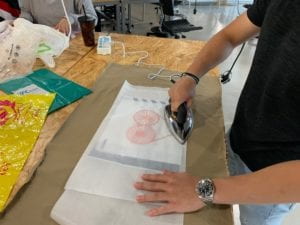Workshop Key Takeaways:
To best get an idea of how to fuse plastics, my partner and I dove right in. We wanted the experiment to be, well, experimental! We wanted to make mistakes and learn from these mistakes. We used a variety of plastics and tried to fuse them to create ‘something’.
Mistake #1 – THE IRON IS HOT.
Each plastic material melted and fused in different temperatures. We tried to fuse plastics that had different weights and widths which can be both a good and bad characteristic – you just have to make sure that you are ironing each plastic mindfully. The iron was so hot that it melted some plastic while thicker material stayed intact and needed more heat.
Mistake #2 – Corners & Edges
We tried to create a pocket or wallet with 3 fused corners and one opening. In order to test the integrity of the fusion, we filled the pocket with water but later found that the corners leaked. Our mistake was that each corner had the most plastic material and needed more time under the iron. Next time, more heat should be applied to folds or corners in order to create a strong – waterproof seal.
Mistake #3 – Time
Although we tried to keep the iron in a low setting/temperature, leaving the iron on for too long will cause it to heat up above the temperature on the gauge. To fix this problem, future projects should be heated in varying parts. The process can’t be rushed and should be done in small sections so that the iron can be turned off and cooled. The cooldown process should reduce the risk of burning the plastic material!
Images:


Project Proposal
“Reclaim”
My project idea is driven by the workshops that I attended with Marcela. After learning how to use the embroidery machine, I wanted to use my found and recycled materials and embroider on them. Ideally, I want to embroider on plastic, but after a failed attempt of sewing my plastic material which caused a sewing needle to shatter – this form of fabrication may change (aka hand-sewing/hand-embroidering).
I want to create (2) separate garments – a top and a bottom. The form whether it be a dress, pants, skirt or etc. is still up in the air. Regardless of the shape, I want these garments to have an embroidered feature which will be native Chinese or Shanghainese plants that will cover the garment. My idea is that plants are reclaiming the space that is once theirs. Instead of the world being overrun by plastic, it will now be plastics being overrun by plants.
I also want the materials to speak for themselves, making the design fashionable but keeping a majority of its integrity (shape, tags, handles, closures, etc.). I also found some great resources online to show that embroidery on recycled materials like plastic is possible.
Inspiration:

Process/Experimentation:



Leave a Reply